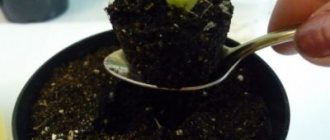Violets in the house: how long do they live, do they need to be rejuvenated, how to rejuvenate and replant violets? Read today's article if the topic is relevant to you.
The plant “once and for a lifetime” is about violet
. This miniature plant is a true long-living record holder among plants. By regularly renewing, replanting and rejuvenating the violet, you can spend decades in the company of your flower friend; the only question is how to properly develop and renew the violet.
In apartment conditions, violets are displayed on window sills and placed next to heating devices
, which can spoil the health of the flower - the leaves will fall off and the earthen ball will dry out.
Diseases can be prevented if you manage the location correctly and renew the shoots. Then the violet lives for 10-15 years without problems
, and then it’s a matter of repeated care.
How to rejuvenate a violet:
- Cut off the apical part when the stem is exposed;
- Sprinkle the remaining “stump” with coal;
- Cuttings can be propagated;
Periodically, the violet will become bare, revealing leaves and shoots
, which signals a lack of nutrition,
aging of the root system
, the need for replanting or pruning.
In this case, all wilted leaves are removed from the plant. You can improve the soil from time to time by removing the top layer and adding new soil. For a more serious renovation, replanting is carried out
: transfer the violet from the pot onto oilcloth, clean it of clods of old soil, inspect and, if necessary, trim the root system.
New soil for planting indoor violets:
- 1 cm of small pebbles on the bottom;
- 1 part sand;
- 1 part leaf soil;
- 1 part turf;
- A couple of pieces of sphagnum moss;
After replanting, the rosette of leaves will be renewed and the violet will return to its former vibrant, varietal color. In a couple of months, new roots will even grow, which will give rise to living shoots - up to 2-3 cm each.
How to rejuvenate a mini violet?
How to rejuvenate violet
in different ways: By adding soil to young plants (by digging).
Re-rooting the socket. ... Adding soil
- Break off or trim the lower leaves.
- Sprinkle the bare stem with a nutrient layer of soil.
- Carefully level the poured soil.
Interesting materials:
How to cancel Xiaomi update? How to cancel payment for YouTube premium? How to cancel a sent email? How to cancel a paid subscription on Facebook? How do I cancel my EA Play subscription? How to cancel your ESO Plus ps4 subscription? How to cancel your boom subscription? How to cancel your Apple Music mts subscription? How to unsubscribe from Facebook? How to cancel a subscription on Samsung?
Saintpaulia: home care
The culture has proven itself to be unpretentious. If you have basic skills, even a novice gardener can grow it. In order for Saintpaulia to feel comfortable at home, a number of parameters must be observed.
Basic requirements (memo):
| Temperature | In winter it should be at least 19˚C, in summer – about 22-25˚C. |
| Air humidity | 55-65%, however, you cannot irrigate the leaves with a spray bottle (to increase the indicator, the pots are placed on expanded clay, which is then sprayed with water). |
| Lighting | Moderate, placement on northern windows is acceptable. |
| Watering Saintpaulia | Depending on the season of the year (in summer, moisten the soil daily, in winter - once every 4 days). |
| Priming | Well-draining, specially designed for violets. |
| Feeding and fertilizer | Only in the warm season (once every 2 weeks). |
| Transfer | Annual (spring) with complete soil replacement. |
| Propagation of Saintpaulia | It is carried out by apical cuttings, air layering and parts of the stem so that several buds are present on it. |
| Peculiarities | Ease of propagation (by cuttings, “babies”, seeds), the possibility of obtaining new varieties with unusual petal colors through artificial pollination. |
The advantage of the Uzambara violet is that there is no need for pruning. The procedure is resorted to if weak leaf plates appear on the Saintpaulia, in case of mechanical damage, and also in order to obtain new plants.
Saintpaulia flowering
The intensity of the process is regulated by changing the level of illumination. With a large amount of sunlight, the Uzambara violet is able to constantly produce buds. However, this is fraught with depletion of the plant. Therefore, it is recommended to move the pot to a shaded place once a year for 1.5-2 months to provide Saintpaulia rest.
The variety of varieties does not allow us to give an unambiguous description of the appearance of the crop. There are both hybrids with simple flowers consisting of 5 petals, and specimens with double buds. They can be monochromatic or combine several shades.
Saintpaulia Chimera
Temperature
The Saintpaulia flower prefers warmth at home. In summer, the room temperature should be 22-25 ˚C, in winter – about 19 ˚C. The plant reacts poorly to excessive heat: during such periods it can completely stop flowering.
Uzambara violets cannot be taken out into the open air. In the warm season, it is allowed to move the pots to a glazed loggia or balcony. In this case, it is necessary to ensure that Saintpaulia is protected from drafts.
Spraying
The culture loves moist air. However, the pubescent leaf blades cannot tolerate water getting on them. Therefore, you cannot irrigate the plant with a spray bottle: this will lead to its rotting.
To maintain the parameter at a level of at least 55%, it is necessary to place containers with flowers in pallets filled with moistened sphagnum or small expanded clay. In this case, you cannot remove the saucers on which the pots are placed. You can purchase an industrial humidifier and turn it on periodically.
Lighting
Saintpaulia - home care, propagation, photos Placement on southern windows is contraindicated for violets. In such conditions, leaf plates will bend outward and curl. The plant develops best when located on the western or eastern side. The optimal length of daylight is 12 hours.
Saintpaulia is shade-tolerant, so it can bloom safely even on a northern window. If few buds appear with such localization, an additional light source (phytolamp) should be installed.
If you have the appropriate equipment, you can grow Saintpaulia at home even in the depths of your apartment.
If the petioles of the leaves are elongated and the plates themselves take a vertical position, the lighting intensity should be increased.
Watering
For moisturizing, use soft water at room temperature that has settled for 3-4 days. Some plant growers prefer thawed or filtered. In summer the procedure is carried out every day, in winter – 2 times a week.
The substrate is watered when its surface is completely dry. This can be done in two ways: using a small watering can or by placing the pot in a container of water for 20-25 minutes. In the first case, you need to make sure that the drops do not fall on the leaves. It is important not to allow moisture to stagnate in the container with the flower.
Soil for Saintpaulias
To prepare the soil, you will need to mix:
- 1 part coarse sand;
- 3 parts peat;
- 5 parts leaf humus.
You can purchase ready-made substrate in the store.
Universal compositions for growing Saintpaulias are not suitable. It is necessary to choose special soils for violets.
Feeding and fertilizer
In its natural environment, the plant lives on depleted soils that contain few nutrients and microelements. Therefore, you cannot get carried away with fertilizing. During the winter, procedures are suspended, resuming them at the end of April. Fertilizing violets with mixtures with a high nitrogen content should be avoided.
For Saintpaulias, Kemira-Lux is suitable. When diluting the drug, add 2 times more liquid than required according to the instructions. Fertilizing is applied once every 2-2.5 weeks. You cannot use organic fertilizers such as “meat” water or tea leaves: this contributes to the appearance of leaf mosquitoes (sciarids) on the substrate.
Transplanting Saintpaulia
When choosing a container for a violet, remember that the diameter of the pot should be 3 times smaller than the diameter of the rosette. The capacity of an adult plant is usually 13 cm in diameter and 10 cm in height.
If you transplant the plant into a larger pot, you risk never enjoying the flowering of Saintpaulia.
The plant itself is difficult to tolerate the process of transplantation. Delicate thin roots are highly susceptible to mechanical damage. Therefore, it is recommended to transfer the plant with a lump of earth into a larger pot.
If you find the presence of rotting on the roots, remove it and, for prevention, place the treated roots in a solution of potassium permanganate.
Rest period
Saintpaulia, fortunately for many gardeners, is an evergreen plant in which, unlike gloxinia, the above-ground part does not die off in winter.
The dormant period is considered to be the time when the violet rests from continuous flowering. Try to provide the violet with a more shaded place with moderate watering. This will allow you to form even more beautiful buds for the new active period.
Planting a leaf with roots in the ground.
When roots approximately 1-1.5 cm long appear on the leaf, it can be planted in soil selected specifically for violets with an acidity of pH 5.5-6.5. Several holes are made in a plastic cup to allow excess moisture to escape, drainage or foam is poured onto the bottom and filled evenly with soil. For a leaf with roots, make a depression in the moist soil, preferably at the edge, and plant it.
We place it in a warm but not sunny place, water it periodically, create greenhouse conditions by covering it with a plastic bag. A cup with drainage holes can be placed in another cup of the same type, but without holes. Thus, the pot will be double - convenient for watering from below.
Depending on the conditions of detention, in one and a half to two months the children will grow up. If after the expiration of the term the children do not appear, it means the stem has rotted. To prevent this from happening, be very careful with watering.
Some features of caring for violets
There are several specific techniques for caring for Saintpaulia Uzambara.
- Pots with violets must be turned over in relation to the sun to give the rosette the correct shape.
- As the flowers mature, the leaves below are carefully trimmed. A bright and beautiful bouquet framed by several rows of green leaves will have a compact shape and look especially attractive.
- Violets age quite quickly, the stem becomes longer, the flowers become smaller. The maximum lifespan is two years. Next, the cut leaves should be used as planting material for young violets
or to “rejuvenate” the plant. To do this, it is cut off at the root, a few young leaves are left and rooted like a young rosette. - To make violet flowers brighter, water it with a solution of potassium permanganate.
The hassle of growing Saintpaulia is more than justified by the end result. It's hard to imagine anything more spectacular among indoor plants than pots of blooming violets. There are about thirty thousand varieties, special exhibitions are held, and there is a club for Saintpaulia lovers. Communication, exchange of experience, attempts at selection - all this unites a large group of people around a small, beautiful and delicate indoor flower - Saintpaulia Uzambara or simply violet.
There are 4 types of growing violets: leaf, peduncle, stepson and cuttings. Each of them is good in its own way, but we offer the simplest, but somewhat time-consuming method of propagating violets - with leaves.
If certain home conditions are created, violets can be propagated all year round. If there is not enough heat and light for this, then it is better to postpone the reproduction process to the spring-summer period.
It is not recommended to take planting material for rooting from the bottom row of the rosette, since the leaves there are old, they may not produce babies, and the leaf will disappear. It is preferable to choose 2-3 mature and mature leaves closer to the topmost tier of the rosette. It is very important that there are no damages, scratches, bends on it, and that it itself is green and elastic.
A leaf is cut from the mother plant at an angle of 45 degrees, leaving a small stump, which is then sprinkled with activated carbon. The length of the stem of the cut leaf should not be more than 4 cm, a smaller size is allowed. Sprinkle the cut with coal and give a little time for the cut to dry.
If the period of time between immersion in water and cutting is long, for example, the leaf was taken at an exhibition or from friends, at home before immersion in water you need to make a fresh cut again and allow it to dry for about 2-3 minutes. Only then can the violet cuttings be placed in water or rooted directly in the ground.
Pests and diseases
When caring for violets at home, you must remember that in the event of a plant disease, it is advisable, if possible, to do without the use of pesticides. They are toxic and harmful not only to people, but also to flowers. Harmless herbal preparations act sparingly. Or a mechanical way to destroy pests - collecting by hand.
Diseases and their treatment
Fragile Saintpaulias are vulnerable to careless care. They may suffer from common diseases.
- Fusarium. The disease affects the leaf rosette, in which the petioles one after another become watery transparent and rot. The disease can be provoked by temperature changes and drafts, as well as watering with cold water. Immediate removal of the affected parts is required, followed by treatment of the rosette and rhizome with a fungicidal solution.
- Rust appears from the spread of fungus. Visual signs are yellow-brown raised spots on the surface of the leaves. It is obvious that the plant needs treatment. Affected leaves should be removed and the entire bush should be treated several times with fungicidal preparations.
- Powdery mildew most often appears on the leaves of Saintpaulia from insufficient lighting and excess humidity. In addition to treatment using a foundation solution, it is necessary to change the living conditions of the flower. Otherwise he won't be able to cope.
- Gray rot is an insidious disease that quickly spreads to the entire plant. It is caused by a complex of unfavorable factors - temperature changes, waterlogging of the soil, insufficient lighting. The leaves become moldy and die. It is extremely difficult to treat. More often than not, the affected plant must be destroyed.
To prevent diseases, daily inspection of indoor plants and watering with Fundazol solution is necessary once every two months. This is a well-proven drug for the prevention and treatment of fungal diseases.
Pests and their control
Saintpaulia violet can get sick and even die from pest attacks. The most common among them:
- aphid;
- all kinds of mites;
- worms that attack roots.
Proper care of violets and daily careful inspection will prevent pest invasion in time. It is recommended to use only herbal preparations for destruction - infusions of garlic and onions, red hot pepper, citrus peels, tomato leaves, tobacco, pyrethrum.
How to feed a violet to make it live longer?
In addition to the standard mixture, additional fertilizers are needed to stimulate development. Violet is often fed with “Uniflor-growth” or “Uniflor-bud”,
which has proven itself well among flower growers. For additional leaf growth, you need constant daylight in the spring and lighting with lamps in the winter.
The violet will live a long time
As it grows, the top of the violet will increase in size
.
We know that the pot is chosen just right for the plant - in a large one, growth stops - but if development is rapid, do not be afraid to change it. No matter how many years an indoor violet lives, it needs to be provided with suitable conditions
, that is, take into account basic needs: pot, soil, watering, temperature, lighting.
In fact, the longevity of violets is based on the characteristics of the variety and the care of the flower.
The last point lies entirely on the shoulders of the florist. Replanting can be done no more than once every 3 years, but the rejuvenation of the rosette of leaves, described above, is done once every 2 years. Removing dead parts and leaves as necessary. With the help of care, you can easily make the violet the first 60 or 80 year old plant in the history of floriculture.
↓ Write in the comments how long does your indoor violet live? How do you renew a plant?
(2
rated, rating:
10.00
out of 10)











